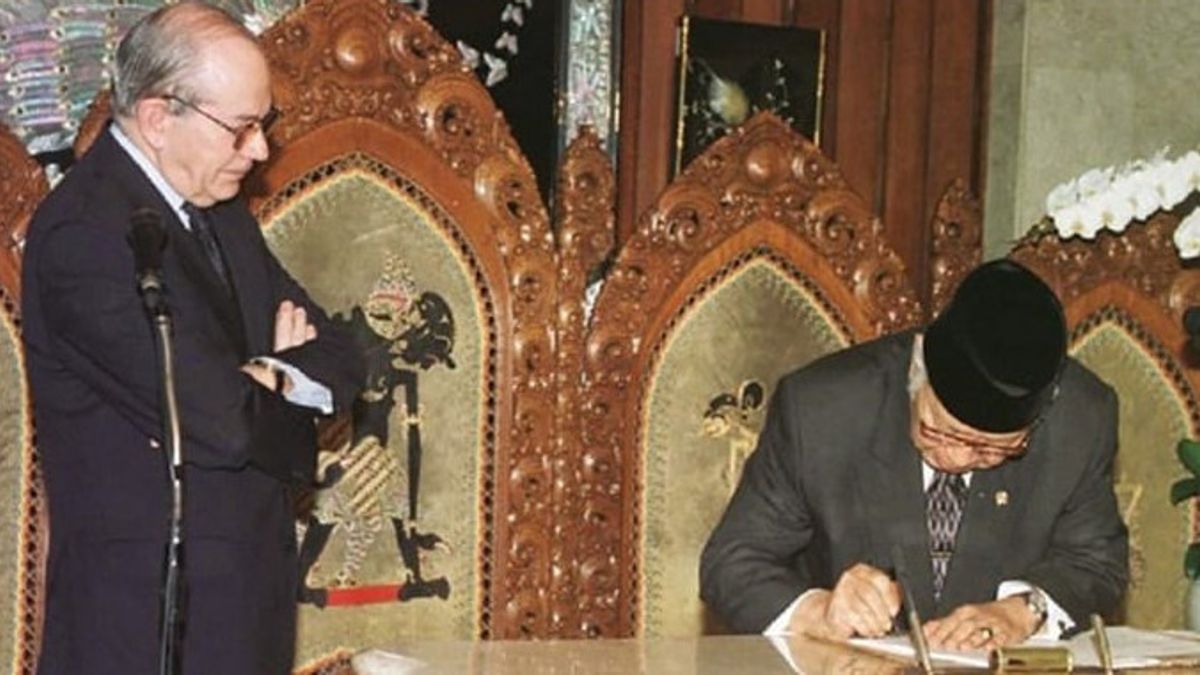JAKARTA - The 1997-1998 economic recession was one of the toughest phases in the history of the Indonesian nation. Suharto and the New Order (Orba) were helpless to hold back the rate of rupiah exchange rate which continued to fall. All kinds of tactics were tried. However, this often leads to failure.
The impact of the failed strategy was everywhere. All domestic private companies are also affected. Their company is threatened with bankruptcy. The only alternative for companies to survive is to perpetuate the politics of mass layoffs.
No one was able to predict the end of the power of Suharto and the New Order. The military power that Orba possessed was behind it. All kinds of disturbances can almost certainly be handled properly. Moreover, it was only their class who criticized Suharto's existence.
This condition made Orba arrogant and hit by the sap. The enemy is no longer students or political figures who interfere with the government. The New Order's enemy before 1997-1988 was an economic recession. The rupiah exchange rate that fell to its lowest level was the bottom line. Its influence makes all Indonesian people miserable.
Prices of staple goods and industrial goods increased sharply. Meanwhile, people's purchasing power is decreasing. This condition was exacerbated by the New Order regime which underestimated the recession. Corruption even persists. Because the government believes it can get through this crisis moment. Even if it means sacrificing the lives of many people.

The moment President Soeharto resigned on May 21, 1998. (Wikimedia Commons)
Orba was not motionless. The owner has the power to do everything to avoid the brink of recession. Rupiah love movement, one of them. A movement that invites all people to immediately exchange dollar bills with rupiah. Instead of success, the movement was in fact not enough. Therefore, the chasm of recession is wide open.
"Entering the new year of 1998 the price of the US dollar far exceeded the IDR 6,000 mark and instead on January 22, 1998, it reached the highest IDR 16,000 in Indonesia's economic history. The prices of staple goods (including rice, soybeans, wheat, vegetables, fruits, and transportation services), as well as industrial products, have increased drastically."
“The increase in prices has further reduced the real value of the rupiah, which has actually been declining since 1991 because the increase in the money supply (26 percent per year) is much faster than the growth in goods and services (7 percent per year). The long drought and the high import content of the Indonesian economic sector forced the government and entrepreneurs to import staple goods and input goods for the continuity of the production process," said Robert Priyanto as written by David Barsamian and Liem Siok Lan in the book Menembus Batas (2008).
Mass Layoffs
The impact of the economic recession is everywhere. The Jakarta stock exchange was devastated. Moreover, modern companies in Indonesia. A number of companies are threatened with bankruptcy. Because, they continue to lose if they continue to force to survive.
The only alternative to save the situation at that time was only one. A number of companies inevitably perpetuate the policy of mass termination of employment (PHK). This effort is considered the savior of the company from bankruptcy. As a test of survival in the midst of uncertain situations.
Mass layoffs are taking place everywhere. All kinds of sectors contributed to perpetuating mass layoffs. From construction to banking. For some employers, mass layoffs are considered effective. Even if the company makes a loss. There are also companies that have carried out mass layoffs but are still out of business.

The option of mass layoffs has made the unemployment rate swell. All Indonesian people -especially students- are outraged. They moved to ask Suharto and the Old Order to end the crisis immediately, but no solution was presented. As a result, Suharto chose to resign from his position as Indonesia's number one person on May 21, 1998.
"Overall, according to the Ministry of Manpower of the Republic of Indonesia, one million workers were laid off due to the monetary crisis until the end of 1997. Layoffs occurred in several business sectors, especially construction, property, and banking."
“Overall, according to the Ministry of Manpower and Bappenas, as explained by economist Revrisond Baswir in 2003, the number of unemployed until the end of 1997 was 5.8 million people. In 1998 the condition got even worse. According to data from the All Indonesian Workers' Union (SPSI), the workforce affected by layoffs during the monetary crisis has reached 30 million people," said Saliman in his article in the Journal of Economics and Education entitled Dampak Krisis Terhadap Ketenagakerjaan Indonesia (2005).
SEE ALSO:
The English, Chinese, Japanese, Arabic, and French versions are automatically generated by the AI. So there may still be inaccuracies in translating, please always see Indonesian as our main language. (system supported by DigitalSiber.id)
















